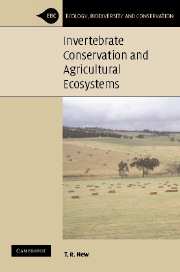Book contents
- Frontmatter
- Contents
- Preface
- Acknowledgements
- 1 Introduction: agricultural ecosystems and conservation
- 2 Agriculture and biodiversity: the place of invertebrates
- 3 Agriculture: effects on invertebrate diversity and conservation
- 4 Agricultural disturbance: diversity and effects on invertebrates
- 5 Biological control and invertebrate conservation
- 6 Cultural aspects of pest management
- 7 Extending beyond cropping areas
- 8 Field margins and landscape ecology
- 9 Pasture management and conservation
- 10 Towards more holistic management for invertebrates
- References
- Index
1 - Introduction: agricultural ecosystems and conservation
Published online by Cambridge University Press: 29 July 2009
- Frontmatter
- Contents
- Preface
- Acknowledgements
- 1 Introduction: agricultural ecosystems and conservation
- 2 Agriculture and biodiversity: the place of invertebrates
- 3 Agriculture: effects on invertebrate diversity and conservation
- 4 Agricultural disturbance: diversity and effects on invertebrates
- 5 Biological control and invertebrate conservation
- 6 Cultural aspects of pest management
- 7 Extending beyond cropping areas
- 8 Field margins and landscape ecology
- 9 Pasture management and conservation
- 10 Towards more holistic management for invertebrates
- References
- Index
Summary
Development of agriculture has had profound effects on natural communities and has involved changes in land-use patterns over much of the world. In general, the changes have involved replacement of complex natural communities by much simpler and less diverse systems, and loss or reduced abundance of numerous species of the fauna (of which invertebrates are predominant components) and flora previously present. Intensification of agriculture has escalated these changes and led to the development of so-called ‘agroecosystems’ as substantial and highly managed terrestrial ecosystems, in which commodity production (rather than conservation) is the major aim and outcome. Agroecosystems are an important arena in which to enhance conservation, including that of invertebrates, for major benefits to biodiversity.
Introduction
Agriculture has been defined as ‘the art, practice, or science of crop and livestock production on organised farm units’ (Pesek, 1993) and is the world's most extensive industry, one upon which humankind depends. Indeed, the future of human populations is linked fundamentally with sustaining agricultural production. Agriculture is thus the single largest component of global land use, with some 36% of the world's land surface devoted to providing the primary produce needed to sustain people (Gerard, 1995). Clearing of natural vegetation to increase this proportion is continuing in many parts of the world. Agriculture is also amongst the most varied suite of activities that may compromise the integrity of natural environments, and the variety of scales and activities associated with a very broad range of products renders generalisations about its wider effects difficult.
- Type
- Chapter
- Information
- Publisher: Cambridge University PressPrint publication year: 2005



